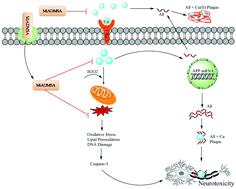当前位置:
X-MOL 学术
›
Metallomics
›
论文详情
Our official English website, www.x-mol.net, welcomes your
feedback! (Note: you will need to create a separate account there.)
Monoisoamyl DMSA reduced copper-induced neurotoxicity by lowering 8-OHdG level, amyloid beta and Tau protein expressions in Sprague-Dawley rats.
Metallomics ( IF 2.9 ) Pub Date : 2020-07-02 , DOI: 10.1039/d0mt00083c Jayant Patwa 1 , Ashima Thakur 2 , Abha Sharma 2 , S J S Flora 1
Metallomics ( IF 2.9 ) Pub Date : 2020-07-02 , DOI: 10.1039/d0mt00083c Jayant Patwa 1 , Ashima Thakur 2 , Abha Sharma 2 , S J S Flora 1
Affiliation

|
Introduction: copper dyshomeostasis has long been linked with several neurodegenerative disorders. The binding of Cu with amyloid beta and other neuronal proteins in the brain leads to the generation of oxidative stress, which eventually causes neurotoxicity. Method: the present study was aimed at elucidating the efficacy of monoisoamyl 2,3-dimercaptosuccinic acid (MiADMSA) and D-penicillamine (DPA) (0.3 mEq kg−1, oral administration for 2 weeks) against Cu(II)-induced (20 mg kg−1, oral administration for 16 weeks) neurotoxicity in Sprague-Dawley (SD) rats. Results: we observed that the MiADMSA treatment modulated the altered oxidative and nitrosative stress parameters, antioxidant enzymes, and acetylcholinesterase (AChE) activity. Significant improvements were noticed in the neurobehavioral parameters except for the memory parameter. We also observed moderate improvement of memory impairment in the rats treated with MiADMSA and DPA post Cu(II) exposure, as assessed by a passive avoidance test. Disease progression involves multiple factors and results in the up-regulation of intra and extracellular proteins such as amyloid beta and tau proteins; the expressions of these proteins were significantly reduced by the treatment proposed in our study, and these results were confirmed by ELISA and qRT-PCR. The expression of caspase-3 was higher in Cu(II)-exposed rats, whereas it was lower in the MiADMSA-treated group. The proposed treatment reduced the copper-induced histological changes in the cortex and hippocampus regions of the brain. Conclusion: it can be summarised from the present study that MiADMSA is effective in reducing Cu(II)-induced oxido-nitrosative stress, antioxidant defense enzymes, neurobehavioral changes, neuronal markers, apoptotic markers, and their genetic expressions. We conclude that chelation therapy using MiADMSA might be a promising approach for the treatment of copper-induced neurotoxicity.
中文翻译:

Monoisoamyl DMSA 通过降低 Sprague-Dawley 大鼠的 8-OHdG 水平、β-淀粉样蛋白和 Tau 蛋白表达来降低铜诱导的神经毒性。
简介:长期以来,铜稳态失调与多种神经退行性疾病有关。Cu与大脑中的β淀粉样蛋白和其他神经元蛋白结合导致氧化应激的产生,最终导致神经毒性。方法:本研究旨在阐明单异戊基 2,3-二巯基琥珀酸 (MiADMSA) 和D-青霉胺(DPA)(0.3 mEq kg -1,口服给药 2 周)对 Cu( II ) 诱导的( 20 毫克公斤-1,口服给药 16 周)对 Sprague-Dawley (SD) 大鼠的神经毒性。结果:我们观察到 MiADMSA 处理调节了氧化和亚硝化应激参数、抗氧化酶和乙酰胆碱酯酶 (AChE) 活性的改变。除记忆参数外,神经行为参数有显着改善。我们还观察到用 MiADMSA 和 DPA 治疗的大鼠在 Cu( II)后记忆障碍的适度改善。) 暴露,通过被动回避测试评估。疾病进展涉及多种因素,并导致细胞内和细胞外蛋白质(如淀粉样蛋白 β 和 tau 蛋白)的上调;我们研究中提出的治疗方法显着降低了这些蛋白质的表达,这些结果通过 ELISA 和 qRT-PCR 得到证实。caspase-3 的表达在 Cu( II ) 暴露的大鼠中较高,而在 MiADMSA 治疗组中较低。拟议的治疗减少了铜诱导的大脑皮层和海马区的组织学变化。结论:从目前的研究可以总结出 MiADMSA 能有效减少 Cu( II)) 诱导的氧化亚硝化应激、抗氧化防御酶、神经行为变化、神经元标记、凋亡标记及其遗传表达。我们得出结论,使用 MiADMSA 的螯合疗法可能是治疗铜诱导的神经毒性的一种有前途的方法。
更新日期:2020-07-02
中文翻译:

Monoisoamyl DMSA 通过降低 Sprague-Dawley 大鼠的 8-OHdG 水平、β-淀粉样蛋白和 Tau 蛋白表达来降低铜诱导的神经毒性。
简介:长期以来,铜稳态失调与多种神经退行性疾病有关。Cu与大脑中的β淀粉样蛋白和其他神经元蛋白结合导致氧化应激的产生,最终导致神经毒性。方法:本研究旨在阐明单异戊基 2,3-二巯基琥珀酸 (MiADMSA) 和D-青霉胺(DPA)(0.3 mEq kg -1,口服给药 2 周)对 Cu( II ) 诱导的( 20 毫克公斤-1,口服给药 16 周)对 Sprague-Dawley (SD) 大鼠的神经毒性。结果:我们观察到 MiADMSA 处理调节了氧化和亚硝化应激参数、抗氧化酶和乙酰胆碱酯酶 (AChE) 活性的改变。除记忆参数外,神经行为参数有显着改善。我们还观察到用 MiADMSA 和 DPA 治疗的大鼠在 Cu( II)后记忆障碍的适度改善。) 暴露,通过被动回避测试评估。疾病进展涉及多种因素,并导致细胞内和细胞外蛋白质(如淀粉样蛋白 β 和 tau 蛋白)的上调;我们研究中提出的治疗方法显着降低了这些蛋白质的表达,这些结果通过 ELISA 和 qRT-PCR 得到证实。caspase-3 的表达在 Cu( II ) 暴露的大鼠中较高,而在 MiADMSA 治疗组中较低。拟议的治疗减少了铜诱导的大脑皮层和海马区的组织学变化。结论:从目前的研究可以总结出 MiADMSA 能有效减少 Cu( II)) 诱导的氧化亚硝化应激、抗氧化防御酶、神经行为变化、神经元标记、凋亡标记及其遗传表达。我们得出结论,使用 MiADMSA 的螯合疗法可能是治疗铜诱导的神经毒性的一种有前途的方法。











































 京公网安备 11010802027423号
京公网安备 11010802027423号